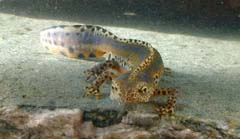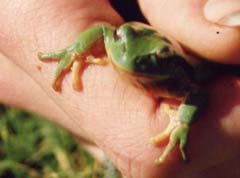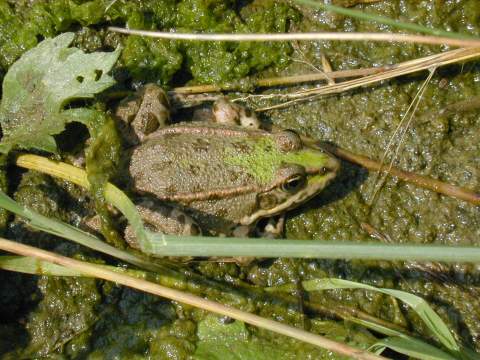
INTRODUCED REPTILES AND AMPHIBIANS IN THE UK
A number of reptile and amphibian species have been introduced by man into the UK. Some have escaped from captivity, some have been accidentally introduced with other materials, and some have been deliberately released.
It is now illegal to release any non-native species into the wild in the UK. A number of species have been listed by the department of the environment as alien species that are now established in the wild, and all these species will be considered here.
The amphibians concerned are:
The reptile species are:
In addition, the American bullfrog Rana catesbeiana, and the red-eared terrapin (Trachemys scripta elegans) are species that have raised concern recently, but are not legally regarded as established species.
There are a number of reasons why alien species may be regarded as environmentally damaging. They may be an agricultural pest, they may endanger public health, or the health of native organisms. They may be a unique predator with no natural controls, or they may breed with native species, threatening the unique genetic identity of these native taxa. They may physically damage natural environments, or they may compete directly with native species, reducing the resources available.
Most of the introduced species seem to pose little threat in any of these ways. There are, however, a couple of exceptions. The Italian crested newt Triturus carnifex, is able to breed with native crested newts Triturus cristatus, themselves a threatened and declining species. The American bullfrog Rana catesbeiana is a voracious predator of many small animals, and, due to its size, is likely to have few predators in the UK.
REASONS FOR FAILURE OF INTRODUCTIONS
Many amphibian and reptile species have been introduced into the British Isles with little success. There are a number of reasons why these species have not become established.
The most common reason is failure to breed. The original introduced animals may survive for a period of time, but a colony will not persist if no breeding takes place. In the reptile species, this is often due to the necessity for high incubation temperatures for eggs. Only two of the native reptile species are egg-layers, and these have very specific requirements to allow high incubation temperatures. The grass snake (Natrix natrix) utilizes rotting vegetation, which will generate heat, and the sand lizard (Lacerta agilis) uses bare sand in a sunny position, which will be at a higher temperature than the surrounding areas. Species from warmer climates may lay eggs in habitats which, in their native areas, will be sufficiently warm, but in Britain will be too cold, and will lead to failure.
Amphibian eggs are less sensitive to temperature variation, and amphibian introductions have resulted in successful breeding on many more occasions.
ALPINE NEWT Triturus alpestris

Male alpine newt
The alpine newt is a species found over much of Europe. This newt is slightly larger than the native smooth and palmate newts, but at around 10-12 cm, is smaller than the crested newt. Alpine newts exhibit a great deal of variation in colour, but their ground colour is usually grey to blue-grey, often with some marbling or spotting. the belly is always a uniform yellow to red colour. Breeding males have a thin white band, spotted with black, running from their cheeks along the lower edge of their sides. They also have a low, straight crest, which is usually white to yellow, with black spotting.
This species has been introduced into Surrey, Berkshire, Shropshire, and Tyne and Wear, and has frequently bred in this country, some introductions having persisted for decades.
ITALIAN CRESTED NEWT Triturus carnifex
As its name suggests, this species can be found in Italy, though its range extends into the Balkans. This newt is very similar in appearance to the native crested newt, the most obvious difference being that females and juveniles have a strong yellow stripe along the back. This species can interbreed with native crested newts.
A colony of this species has existed in Surrey for many years. This species was previously imported in large numbers for the pet trade, and it is possible that there have been many more introductions. The similarity of this species to the native crested newt means that introductions of this species may not be recognised as such.
MIDWIFE TOAD Alytes obstetricans
The midwife toad is a small toad originating from central Europe. Adults grow to around 5 cm in length, and have remarkable breeding behaviour, where the male carries a string of eggs wrapped around his hind legs, which he maintains at an optimal level of moisture by periodically immersing them in water. When they are ready to hatch, he again immerses them, allowing them to swim away, where they develop as in other toads, although having a rather large tadpole. Adults of this species are similar in appearance to common toads, though smaller, with more pointed noses. They are stronger jumpers than the common toad, and their eyes have vertical, cat-like pupils, unlike the horizontally rounded pupils of the common toad. They also have a distinct bell-like call.
Midwife toads were introduced into Bedford sometime around the early 1900s, possibly accidentally with plants from Europe. They have survived since then, and stock from this introduction was used to start another colony near Worksop, which is also still surviving, and has spread over several miles. This species has recently been reported in Buckinghamshire and Hertfordshire, and a colony existed in South Devon from 1954 to at least 1964. An introduction to a garden in York persisted from 1933 until after 1979.
These toads seem to thrive in garden environments, most of the known colonies being associated with human habitation.
EUROPEAN TREE FROG Hyla arborea

The closely related Hyla meridionalis
The European tree frog is a bright green species, growing to around 7cm in length. It has sticky toe pads, allowing it to climb easily. This species has been present in the New Forest since the 1880s, though the origin of any introduction is obscure. It was introduced into South-East London in the 1970s. Despite repeated breeding success, both colonies are thought to have died out in the late 1980s. (Snell, 1991, & Snell, personal communication).
This species has an extremely loud, distinctive call. Click here to download a recording of the call of this species (46KB, kindly provided by Raimund Specht of www.avisoft.de.).
MARSH FROG Rana ridibunda (=Pelophylax ridibundus)

Young marsh frog (Rana ridibunda) from Yorkshire
This species has been the most successful of all those introduced into the UK. A dozen Hungarian specimens of this large (up to 13cm), water-dwelling greenish-brown frog was introduced into a garden on the edge of Romney Marsh in Kent, in 1934-5. They have since spread over an area of some 100 square kilometres of Kent and East Sussex. There are smaller colonies in other parts of the UK, the furthest north probably being in East Yorkshire.
Marsh frogs rarely move far from water, but the Romney Marsh area has many interconnecting ditches and dykes allowing the species to spread easily. The impact of this species on native environments is not well known. The area is characterised by close-grazed pasture, used for sheep grazing, which does not support many other amphibians. Marsh frogs will often bask in the sun on the edge of these ditches, and will jump into the water with a characteristic 'plop' when disturbed.
The marsh frog has a distinctive call. The name ridibunda means 'laughing', and refers to the sound of this call. Click here to download a recording of the call of this species (155KB, kindly provided by Raimund Specht of www.avisoft.de.)
Marsh frogs have a similar life-cycle to the common frog, though their spawn is somewhat different. Marsh frog spawn does not float on the surface like common frog spawn, and the jelly is not as dense. The tadpoles are much larger than common frog tadpoles, and young marsh frogs are also correspondingly larger at metamorphosis, being up to 3cm in length.
EDIBLE FROG Rana esculenta (=Pelophylax esculentus)
The edible frog is closely related to the marsh frog, and similarly spends most of its time in the water, or basking on the edge of waterbodies. This species varies greatly in colouration, ranging from yellow through bright green to brown, and often having a bright green or yellow stripe along the back. This stripe is not seen in the the UK marsh frog colonies around Romney Marsh, though it is sometimes seen in marsh frogs from other countries.
This species has been introduced into the south and southeast of England many times. Few introductions persisted for long, though there are still a number of thriving colonies. There is a complex genetic relationship between this species, the pool frog, Rana lessonae, and the marsh frog, Rana ridibunda, which has resulted in some uncertainty as to which species is involved in which introduction. Recent work involving comparison of calls with those of known species has helped to clarify the species present in a number of persisting introductions (Wycherley et al, 2003).
The pool frog is extremely similar to the edible frog, and is very likely to have been introduced at the same time as this species. The pool frog was once native to the UK (see here for more details), and introductions of the edible frog and pool frog may have been confused with native populations of the pool frog.
AFRICAN CLAWED FROG Xenopus laevis
These frogs are grey in colouration, with an egg- shaped body. The head is pointed, with very small eyes towards the top. Clawed frogs have very thick and powerful hind legs, with strongly webbed feet. The black 'claws' at the end of each toe give this species its common name. The fore feet, however, have very thin, pointed toes. The tadpoles of this species are a silvery colour, and have two forward pointing 'antennae'.
This aquatic frog was widely maintained in laboratories and hospitals for many years, as well as being imported for the pet trade. Its most well known laboratory use was in pregnancy testing. This has resulted in a number of extensions to its range occuring across the world. Two areas are known in the UK, where these animals have reproduced in the wild- one on the Isle of Wight, where the species was known to be present until the mid 1970s, and one in South Wales, known still to be present in the late 1990s. The South Wales populations have been studied in some detail (Measey & Tinsley, 1998), and there is evidence for repeated, if infrequent, breeding. The largest population found composed over 1000 individuals.
YELLOW-BELLIED TOAD Bombina variegata

Yellow-bellied toad
The yellow-bellied toad is a small (up to 5cm length) toad with a colourful yellow or orange belly. The dorsal side is very dull in comparison, being a muddy brown or grey. This species is very aquatic, spending most of its time floating on the surface of the water and swimming to the bottom when disturbed.
The similar oriental fire-bellied toad (Bombina orientalis) has been, and still is, imported in large numbers for the pet trade, and this is another species which could possibly be found as an escape, though it has not been reported to have bred in the wild in the UK. This species is brighter in colour than the yellow-bellied toad, having a yellow to bright red belly, and usually showing at least some green on the back.
Introductions of the yellow-bellied toad were made in Devon in the 1960s, and breeding occured for several years, but the colonies do not seem to have persisted.
AMERICAN BULLFROG Rana catesbeiana
This species is a large and powerful frog, up to 30cm in length, originating in the southern USA. It is easily distinguished from native species by size, and by its markings. The tadpoles of this species were widely imported into the UK until recently, possibly accidentally in consignments of water plants, and were often sold on cheaply by garden centres. The tadpoles of this species may take as long as two years before metamorphosis, giving 'froglets' of this species the advantage of greater size (up to 35mm) than that of native species.
This wide distribution of tadpoles is resulting in reports of bullfrogs from many areas of the UK. Worryingly, the species is now thought to have reproduced in the wild. In spring 2000, it was reported that 7000 specimens of this species had been found at a site in Kent, and these were thought to have resulted from a wild spawning. The waterbodies concerned have now been filled in.
English Nature have provided information on the bullfrog in the UK here, including details of how to identify them, and what to do if you find one.
AESCULAPIAN SNAKE Elaphe longissima
This snake is somewhat larger than any of the native species, being up to 180cm in total length. It is plain in colouration, being a brown, reddish or olive above, and yellowish below. There is a strong angular edge to the sides of the belly, which gives this snake a good climbing ability. These snakes are strong constrictors, and feed mainly on small mammals.
Aesculapian snakes are native to central Europe, and it is possible that the northern limits of their range were extended due to Romans keeping them in temples dedicated to Aesculapius. A gravid female specimen escaped from the Colwyn Bay Mountain Zoo in North Wales in the 1980s, and a number of young specimens were captured nearby several years later. It is still thought to persist in this area.
The wall lizard is slightly larger than the common lizard (up to 20cm), though a larger proportion of this is accounted for by the tail. This is a very variable species, but is usually brown in colour, often with a green tinge.
This lizard, unlike the common lizard, is an egg-laying species.
Many introductions have taken place in the UK, as this species was previously imported in large numbers for the pet trade. Colonies still exist in Surrey, Sussex, South London and the Isle of Wight. This species also occurs naturally on Jersey (go here for more details).
EUROPEAN POND TERRAPIN Emys orbicularis
This water-dwelling chelonian has a dark brown shell, patterned with thin yellow lines, The similarly dark head and legs are spotted with yellow. This species was widely imported from continental Europe in the past, and has been released into the wild at several times. An introduction into Suffolk in the 1880s is thought to have resulted in breeding in the wild, as a number of young were captured in 1929. This colony survived until at least 1934. This species is an egg-layer, producing a clutch of up to 16 eggs, which are buried in soft ground. Like many chelonians, this species is relatively long-lived, and so an introduction may persist for many years with no breeding success.
RED-EARED TERRAPIN Trachemys scripta elegans
This North American terrapin was imported for the UK pet trade in vast numbers in the 1980s, primarily as hatchlings. These 3cm long animals were often abandoned when they grew larger- adults are around 15-20cm in length. Many urban centres have reported sightings of these terrapins, though this egg-laying species is not known to have reproduced in the wild in the UK.
Other aquatic chelonians have similarly been abandoned on growing to an undesirable size, including snapping turtles.
OTHER SPECIES
A large number of other reptile and amphibian species have been released in limited numbers in the UK, with little or no success.
Species that have been reported to have bred at least once, but have not persisted, include:
Fire salamander, Salamandra salamandra
Australian tree frog, Litoria ewingi
Painted frog, Discoglossus pictus
Green lizard, Lacerta viridis
Dice snake, Natrix tesselata
Other species imported or bred in large numbers for the pet trade may turn up in the UK, following escape or abandonment. Temperate species may survive for some time, and are occasionally found later, usually in urban areas. Snakes in particular survive well, as they can go without food for prolonged periods of time. The species most likely to be encountered are:
Corn snake, Elaphe guttata
Common rat snake, Elaphe obsoleta
Garter snake, Thamnophis sirtalis
REFERENCES
Measey, G.J., & Tinsley, R. C., 1998. Feral Xenopus laevis in South Wales. The Herpetological Journal 8:23-27.
Snell, C. A., 1991. Disappearance of Britain's Tree Frog Hyla arborea Colonies. British Herpetological Society Bulletin 38:40.
Wycherley, J., Doran, S., & Beebee, T. J. C., 2003. Tracing aliens: identification of introduced water frogs in Britain by male advertisement call characteristics. The Herpetological Journal 12(4): 43-50.